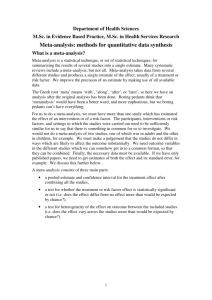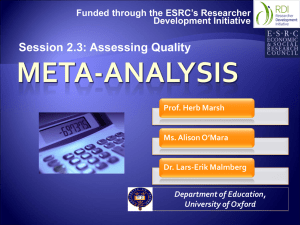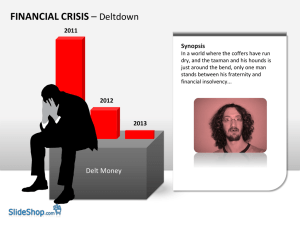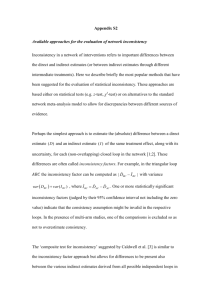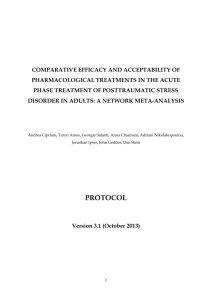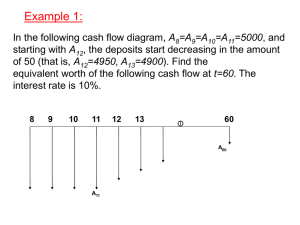uk13_white
advertisement
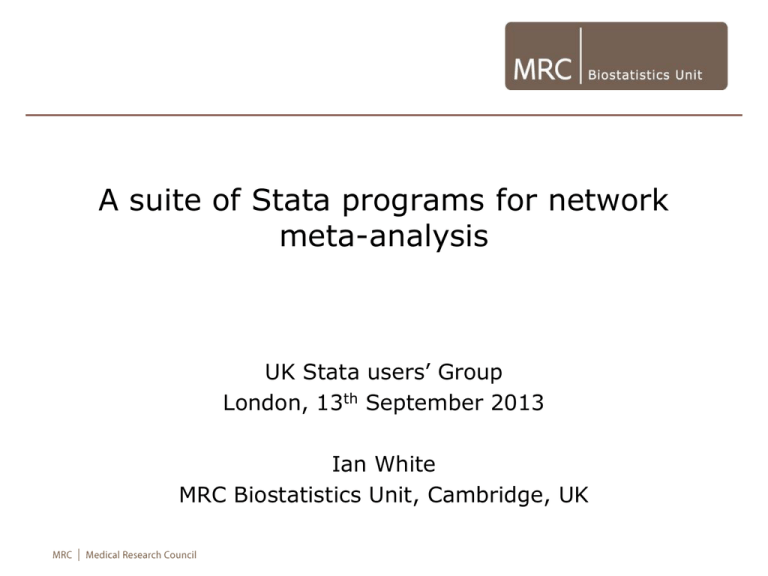
A suite of Stata programs for network meta-analysis UK Stata users’ Group London, 13th September 2013 Ian White MRC Biostatistics Unit, Cambridge, UK Plan • Ordinary (pairwise) meta-analysis • Multiple treatments: indirect comparisons, consistency, inconsistency • Network meta-analysis: models • Fitting network meta-analysis: WinBUGS and Stata • Data formats • network: its aims and scope; fitting models in different formats; graphical displays • My difficulties 2 Pairwise meta-analysis: data from randomised trials study 1 6 7 8 9 10 11 12 13 14 15 16 17 18 19 dA 9 75 2 58 0.5 3 1 6 95 15 78 69 64 5 20 nA 140 731 106 549 34 100 31 39 1107 187 584 1177 642 62 234 dC 23 363 9 237 9.5 31 26 17 134 35 73 54 107 8 34 nC 140 714 205 1561 49 98 95 77 1031 504 675 888 761 90 237 Aim is to compare individual counselling (“C”) with no contact (“A”). In arm A, C: • dA, dC = # who quit smoking • nA, nC = # randomised 3 Pairwise meta-analysis: random-effects model • Assume we’re interested in the log odds ratio • Model for “true log odds ratio in study i”: 𝜇𝑖 ~ 𝑁 𝜇, 𝜏 2 • Parameters of interest: – 𝜇 is the overall mean treatment effect – 𝜏 2 is the between-studies (heterogeneity) variance • Model is useful if the heterogeneity can’t be explained by covariates (type of trial) / outliers (weird trials) • Two-stage estimation procedure • Results from study 𝑖: – Estimated log odds ratio 𝑦𝑖 with standard error 𝑠𝑖 • Model for point estimate: 𝑦𝑖 ~ 𝑁 𝜇𝑖 , 𝑠𝑖2 4 Pairwise meta-analysis: forest plot (metan) Study ID Odds ratio (95% CI) 1 2.86 (1.27, 6.43) 6 9.05 (6.83, 11.97) 7 2.39 (0.51, 11.26) 8 1.52 (1.12, 2.06) 9 16.11 (0.90, 287.30) 10 14.96 (4.39, 50.94) 11 11.30 (1.47, 87.18) 12 1.56 (0.56, 4.33) 13 1.59 (1.21, 2.10) 14 0.86 (0.46, 1.61) 15 0.79 (0.56, 1.11) 16 1.04 (0.72, 1.50) 17 1.48 (1.06, 2.05) 18 1.11 (0.35, 3.57) 19 1.79 (1.00, 3.22) Overall (I-squared = 92.4%, p = 0.000) 1.92 (1.71, 2.16) .2 .5 favours A 1 2 5 favours C 10 20 Study-specific results: here the odds ratio for quitting smoking with intervention C (individual counselling) vs. A (no contact) The random-effects analysis gives a pooled estimate allowing for heterogeneity. 5 But actually the data are more complicated … study 1 2 3 4 5 6 7 8 9 10 11 12 13 14 15 16 17 18 19 20 21 22 23 24 dA 9 nA 140 79 18 8 75 2 58 0 3 1 6 95 15 78 69 64 5 20 0 702 671 116 731 106 549 33 100 31 39 1107 187 584 1177 642 62 234 20 dB nB 11 77 21 19 78 694 535 146 20 7 49 66 dC 23 12 nC 140 85 363 9 237 9 31 26 17 134 35 73 54 107 8 34 714 205 1561 48 98 95 77 1031 504 675 888 761 90 237 16 43 12 9 76 55 dD 10 29 nD 138 170 9 20 32 20 3 127 74 26 Trials compared 4 different interventions to help smokers quit: A="No contact" B="Self help" C="Individual counselling" D="Group counselling" 6 Indirect comparisons • We have trials of different designs: – A vs B – A vs C – A vs D – B vs C – B vs D – C vs D – A vs C vs D – B vs C vs D • We can use indirect evidence: e.g. combining A vs B trials with B vs C trials gives us more evidence about A vs C (we call the A vs C and A vs C vs D trials “direct evidence”) 7 Network meta-analysis • If we want to make best use of the evidence, we need to analyse all the evidence jointly • May enable us to identify the best treatment • A potential problem is inconsistency: what if the indirect evidence disagrees with the direct evidence? • The main statistical challenges are: – formulating and fitting models that allow for heterogeneity and inconsistency – assessing inconsistency and (if found) finding ways to handle it • Less-statistical challenges include – defining the scope of the problem (which treatments to include, what patient groups, what outcomes) 8 Network meta-analysis: the standard model, assuming consistency 𝐼𝐽 • Let 𝑦𝑑𝑖 be the estimated log odds ratio (or other measure) for treatment J vs. I in study i with design d 𝐼𝐽 • Let 𝑠𝑑𝑖 be its standard error 𝐼𝐽 𝐼𝐽 𝐼𝐽 𝐼𝐽 • Model is 𝑦𝑑𝑖 ~ 𝑁(𝜇𝑑𝑖 , (𝑠𝑑𝑖 )2 ) where 𝜇𝑑𝑖 ~ 𝑁(𝛿 𝐽 − 𝛿 𝐼 , 𝜏 2 ) • 𝛿 𝐽 is the mean effect of J vs. a reference treatment A – we make sure that results don’t depend on the choice of reference treatment • 𝜏 2 is the heterogeneity (between-studies) variance – assumed the same for all I, J: data are usually too sparse to estimate separate heterogeneity variances 𝐼𝐽 𝐼𝐽 • to allow for inconsistency: 𝜇𝑑𝑖 ~ 𝑁(𝛿 𝐽 − 𝛿 𝐼 +𝜔𝑑 , 𝜏 2 ) – true treatment effects are different in every design 𝐼𝐽 – we regard the 𝜔𝑑 as fixed (but could be random) 9 Network meta-analysis: multi-arm trials • Multi-arm trials contribute >1 log odds ratio – need to allow for their covariance – mathematically straightforward but complicates programming • With only 2-arm trials, we can fit models using standard meta-regression (Stata metareg) • Multi-arm trials complicate this – need suitable data formats and multivariate analysis 10 Data format 1: Standard Study Contrast 1 Contrast 2 y1 y2 var(y1) var(y2) cov(y1,y2) 1 C-A D-A 1.051 0.129 0.171 0.119 0.227 2 C-B D-B 0.001 0.225 0.203 0.106 0.147 3 B-A . -0.016 . 0.029 . . 4 B-A . 0.394 . 0.107 . . 5 B-A . 0.703 . 0.195 . . 6 C-A . 2.202 . 0.020 . . • different reference treatments in different designs • y1 (log OR for contrast 1) has different meanings in different designs • need to (meta-)regress it on treatment covariates: e.g. (xB, xC, xD) = (0,1,0) for y1 in study 1, (0,0,1) for y2 in study 1, (-1,1,0) for y1 in study 2, etc. 11 Data format 2: Augmented study design yB yC yD SBB 1 ACD . 1.051 0.129 . 3 AB -0.016 . . 0.029 4 AB 0.394 . . 0.107 5 AB 0.703 . . 0.195 6 AC . 2.202 . . SBC . . . . . SBD . . . . . SCC 0.171 . . . 0.020 SCD 0.119 . . . . SDD 0.227 . . . . • same reference treatment (A) in all designs • simplifies modelling: just need the means of yB, yC, yD • problems arise for studies with no arm A: I “augment” by giving them a very small amount of data in arm A: study design yB yC yD SBB 0.225 3000.00 SBC SBD SCC 3000.00 3000.00 3000.20 3000.00 . 3000.18 . . . 3000.20 2 BCD 0 0.001 21 BC 0 -0.152 22 BD 0 . 1.043 3000.00 . 3000.00 . 23 CD . 0 0.681 . . . 3000.00 24 CD . 0 -0.405 . . . 3000.00 . 3000.00 SCD SDD 3000.11 3000.15 3000.00 3000.17 12 3000.00 3000.51 Fitting network meta-analyses • In the past, the models have been fitted using WinBUGS – because frequentist alternatives have not been available – has made network meta-analysis inaccessible to non-statisticians • Now, consistency and inconsistency models can be fitted for both data formats using multivariate metaanalysis or multivariate meta-regression – using my mvmeta • Parameterising the consistency model for “augmented” format is easy • Allowing for inconsistency and “standard” format is trickier … 13 Aims of the network suite • Automatically convert network data to the correct format for multivariate meta-analysis • Automatically set up mvmeta models for consistency and inconsistency, and run them • Provide graphical displays to aid understanding of data and results • Handle both standard and augmented formats, and convert between them, in order to demonstrate their equivalence • Interface with other Stata software for network metaanalysis 14 Initial data 15 Set up data in correct format 16 17 Fit consistency model (1) 18 Fit consistency model (2) estimated treatment effects vs. A estimated heterogeneity SD (t) 19 Which treatment is best? 66% chance that D is the best (approx Bayes) 20 Fit inconsistency model (1) 21 Fit inconsistency model (2) 22 - including a test for inconsistency no evidence of inconsistency 23 Now in standard format … 24 25 estimated treatment effects vs. A estimated heterogeneity SD (t) 26 Graphics • can convert to “pairs” format (one record per contrast per study) and access the routines by Anna Chaimani & Georgia Salanti (http://www.mtm.uoi.gr/STATA.html) • e.g. networkplot graphs the network showing which treatments and contrasts are represented in more trials B C A Next: my extension of the standard forest plot … D 27 Smoking network B vs. A C vs. B Study 3 Study 4 Study 5 All A B All studies Study 21 All B C Study 2 All B C D All studies C vs. A D vs. B Study 6 Study 7 Study 8 Study 9 Study 10 Study 11 Study 12 Study 13 Study 14 Study 15 Study 16 Study 17 Study 18 Study 19 All A C Study 2 All B C D Study 22 All B D All studies D vs. C Study 1 All A C D Study 1 All A C D Study 2 All B C D All studies Study 23 Study 24 All C D D vs. A All studies Study 1 All A C D Study 20 All A D All studies -2 0 2 4 6 -2 0 2 4 6 Log odds ratio Studies Test of consistency: chi2=5.11, df=7, P=0.646 Pooled within design Pooled overall 28 Another data set: 8 thrombolytics for treating acute myocardial infarction C B D E A F H G 29 Thrombolytics network B vs. A G vs. A Study 1 All A B D All studies G vs. B Study 12 All A G All studies Study 20 Study 21 All B G All studies C vs. A H vs. A Study 3 Study 4 Study 5 Study 6 Study 7 Study 8 Study 9 All A C Study 2 All A C H Study 2 All A C H All studies H vs. B Study 22 Study 23 All B H All studies Study 13 Study 14 Study 15 Study 16 All A H G vs. C Study 24 Study 25 Study 26 All C G All studies D vs. B All studies Study 1 All A B D All studies D vs. A Study 1 All A B D H vs. C Study 2 All A C H E vs. B Study 10 All A D Study 17 All B E All studies All studies Study 27 Study 28 All C H F vs. A All studies F vs. B Study 11 All A F All studies Study 18 Study 19 All B F All studies -2 0 2 4 -2 0 2 4 -2 0 2 4 Log odds ratio Studies Test of consistency: chi2=8.61, df=8, P=0.377 Pooled within design Pooled overall 30 A difficulty • In network forest: I need to make the symbol sizes proportional to 1/se2 (using [aweight=1/se^2]) – across all panels – across all plots (i.e. the different colours) • This doesn’t happen automatically – I think scatter makes the largest symbol in each panel the same size • I’m still not sure I have got it right … Smoking network B vs. A C vs. B Study 3 Study 4 Study 5 All A B All studies Study 21 All B C Study 2 All B C D All studies C vs. A D vs. B Study 6 Study 7 Study 8 Study 9 Study 10 Study 11 Study 12 Study 13 Study 14 Study 15 Study 16 Study 17 Study 18 Study 19 All A C Study 2 All B C D Study 22 All B D All studies D vs. C Study 1 All A C D Study 1 All A C D Study 2 All B C D All studies Study 23 Study 24 All C D D vs. A All studies Study 1 All A C D Study 20 All A D All studies -2 0 2 4 6 -2 0 2 4 Log odds ratio Studies Pooled within design Pooled overall Test of consistency: chi2=5.11, df=7, P=0.646 31 6 Difficulty in scaling symbols (continued) 2 1 y 1.5 .5 Sizes don’t scale correctly across by-groups. 2 2.5 1 .5 clear input x y size group 1 1 10 1 2 2 100 1 1 1 100 2 2 2 1000 2 end scatter y x [aw=size], /// by(group) ms(square) /// xscale(range(0.5 2.5)) /// yscale(range(0.5 2.5)) 1 1.5 2 2.5 .5 1 1.5 2 2.5 x Graphs by group 32 1.2 1.4 1.6 1.8 1 clear input x y ysize z zsize 1 1 10 2 50 2 2 100 1 500 end twoway (scatter y x [aw=ysize], ms(square)) (scatter z x [aw=zsize], ms(square)), xscale(range(0.5 2.5)) yscale(range(0.5 2.5)) xsize(4) ysize(4) 2 Difficulty in scaling symbols (continued) 1 1.2 1.4 1.6 1.8 x y 2 z Sizes don’t scale correctly across variables. 33 Future work (1) Ten SK + tPA • Better automated “network plot”? SK AtPA Ret C B D tPA E UK A F H ASPAC G Single study (three arms) Single study (two arms) Multiple studies (two arms) 34 Future work (2) • Release to users • Allow more complex variance structures for the heterogeneity terms • Random inconsistency model Thanks to Julian Higgins, Dan Jackson and Jessica Barrett who worked with me on this. Key references: • Lu G, Ades AE. Assessing evidence inconsistency in mixed treatment comparisons. Journal of the American Statistical Association 2006; 101: 447– 459. • White IR, Barrett JK, Jackson D, Higgins JPT. Consistency and inconsistency in network meta-analysis: model estimation using multivariate meta-regression. Research Synthesis Methods 2012; 3: 111–125. 35 Underlying code for forest plot graph twoway (rspike low upp row if type=="study", horizontal lcol(blue)) (scatter row diff if type=="study" [aw=1/se^2], mcol(blue) msymbol(S)) (rspike low upp row if type=="inco", horizontal lcol(green)) (scatter row diff if type=="inco" [aw=1/se^2], mcol(green) msymbol(S)) (rspike low upp row if type=="cons", horizontal lcol(red)) (scatter row diff if type=="cons" [aw=1/se^2], mcol(red) msymbol(S)) (scatter row zero, mlabel(label2) mlabpos(0) ms(none) mlabcol(black)) , ylabel(#44, valuelabel angle(0) labsize(vsmall) nogrid ) yscale(reverse) plotregion(margin(t=0)) ytitle("") subtitle("") by(column, row(1) yrescale noiytick note(`"Test of consistency: chi2=5.11, df=7, P=0.646"', size(vsmall))) legend(order(1 3 5) label(1 "Studies") label(3 "Pooled within design") label(5 "Pooled overall") row(1) size(small)) xlabel(,labsize(small)) xtitle(,size(small)) xtitle(Log odds ratio) ; 36



